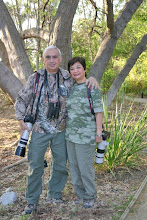I'd like to think of myself as an average birder and bird photographer. As a birder, I can pretty much identify many of the species I encounter in the field. As a bird photographer, I can say that I've had some good moments where my shot turned out quite nicely. Even passable for publication, if I may say so (although none of of my photographs have been published with an appropriate compensation....yet). Whenever my wife and I go on a birding trip my being a birder and a bird photographer usually are in harmony. Yet there are some rare instances when a deep schism develops between my two hobby personalities. Such was the case last Saturday.
Cynthia and I went to the Eaton Canyon Wash in Pasadena. This is the place where after some heavy rain, the waters from the San Gabriel mountains end up as some sort of mini lake. During summer though, the place is very dry with a few patches of vegetation surviving. A grove of eucalyptus trees stand tall on its perimeter offering refuge to the local avifauna. An earlier encouraging report that says this place has become quite birdy made us decide to see for ourselves if it was indeed.Of particular interest was the mention of Lazuli Buntings inhabiting the place. This beautiful blue, orange and white species has been on our most wanted to photograph list. We have had prior experiences with this Bunting but the results had not been satisfactory.
It was already hot and humid when we started our trek - our destination about three-fourths of a mile over uneven rocky and sandy terrain. Just as we entered the "wash" we were met by two very young, scraggly Rock Wrens. They hopped alongside our trail, once in a while hiding behind a rock and then suddenly popping out again greeting us with a couple of bobs with its brown body.
When we reached the place where most of the vegetation were concentrated we could tell that the place was in fact quite birdy. I concentrated on the thicket while Cynthia stalked the nearby eucalyptus trees. It wasn't long when the Lazulis responded even to my pathetic pishing. I was still doing my crude pishing tactics when a brightly colored bird flew into my line of vision.
"Red! Red!" was all I could tell my wife, all the while pointing to the bird that was eyeing us curiosly.
"Shoot! Shoot!" my wife replied curtly as she herself started to photograph the brightly colored bird.
As a birder I knew that we have chalked up another lifer, the Northern Red Bishop, a weaver-bird normally found in Africa. These are probably the descendants of some escaped caged birds and now have established themselves here in Southern California. They are gorgeous - not really red - but more deep orange and black and about the size of a sparrow. Needless to say, we were both so excited at this unexpected treat.
It was when we were home and I was uploading our pictures to the computer that the schism I was talking about happened. I blew it as a bird photographer. Big time! The birder in me who was able to easily identify this very uncommon bird hated the bird photographer in me who failed to get even one decent shot of our lifer. Apparently sometime between the Rock Wrens and vegetated area, for some reason that totally escapes me, the settings of my camera have been changed. For one, the IS (Image stabilization) feature was turned to off. Now without a tripod and trying to focus at a tiny object 500 feet away with the heart beating wildly due to excitement, the IS is a must. Not one photograph came out sharp. None of the Bishops, none of the Lazuli Buntings, none of the half-dozen or so other species that we saw. I have committed a mistake that no self-respecting bird photographer ever makes - not checking the camera settings before each photo op.
Cynthia, on the other hand, was a little luckier. At least her IS was on. However, with the Red Bishop she was standing much further than I was from the bird. And like me, she had only the center focus point on thus getting a bead on a tiny, moving bird with shaky, excited hands was quite difficult. At least with the Lazuli Buntings, she had better success, albeit with the drab, brown female.
Lest I suffer the opprobrium from the bird photography community, I shall not post the picture of the Red Bishop.
It will be a while before the birder in me forgives my bird photographer side.




No comments:
Post a Comment